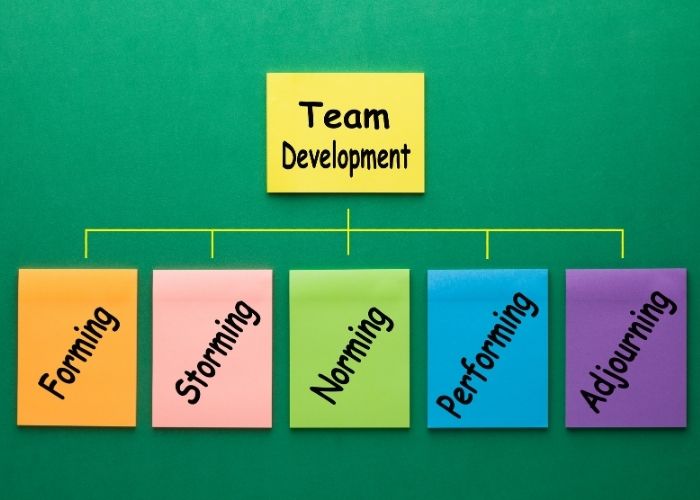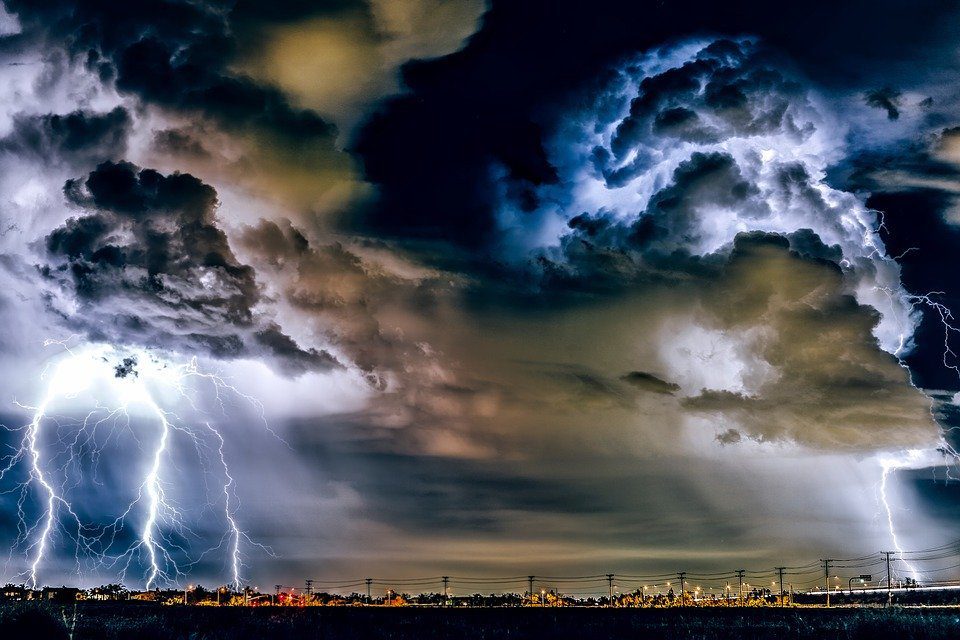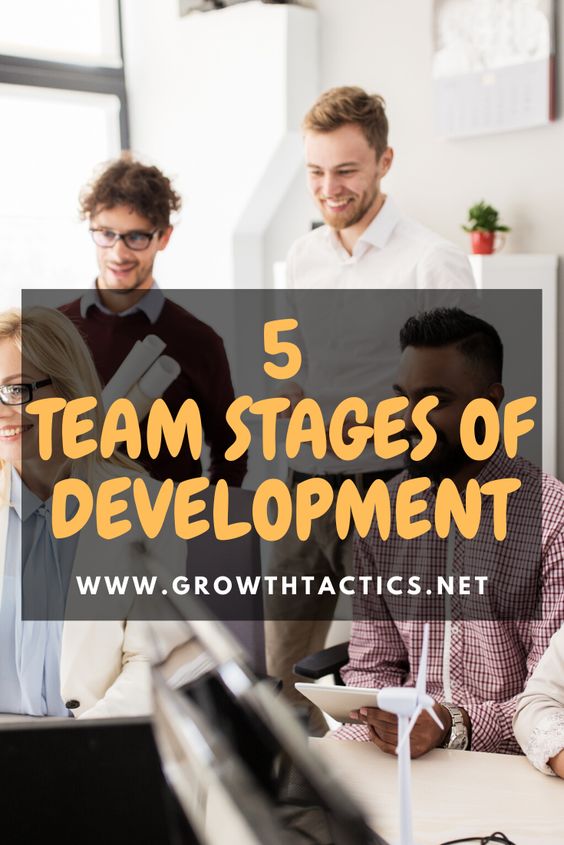So you’ve just formed a new group, huh? Well, get ready to embark on an exciting journey because every newly formed group goes through the 5 stages of group dynamics. And let me tell you, these stages are the secret sauce to creating a harmonious team with amazing chemistry!
Now, don’t expect teamwork to magically happen overnight. Trust me, it takes some time. But hey, that’s okay! Some groups sail through these stages faster than a lightning bolt, while others take their sweet time. But rest assured, every single group out there goes through these stages.
Alright, let me introduce you to the fabulous five stages: forming, storming, norming, performing, and adjourning. These stages were discovered by the brilliant Bruce Tuckman back in 1965, and it was coined the Tuckman Model. In 1970, he decided to add an extra stage called adjourning. This model is like a roadmap that perfectly explains the development of teams and how they evolve over time.
Now, here’s the juicy part. Understanding these stages will give you the power to fast-track your team’s journey from forming to performing. So buckle up, my friend, because we’re about to dive into the exciting world of team development!
Jump To Section
Why the 5 Stages of Group Dynamics Matter
As a supervisor and leader, understanding the stages of group development can help you progress your group through them faster and build strong team dynamics. It also helps you know what to expect when forming a new group. Too often supervisors think a team is a complete failure when they go through the storming stage.
I have seen this many times in my career and a lot of times instead of helping the group advance through this stage, supervisors end up prolonging it. It’s important to notice when the group is going into a stage so you can help them progress through it.

What are Team Dynamics?
Team Dynamics Defined
Team dynamics or group dynamics are the intangible factors that contribute to how a team performs together. It encompasses the complex interactions between team members, the shared values and goals, communication patterns, and the level of trust and collaboration between team members. As a supervisor and leader, understanding how to get the best team dynamics out of your group is crucial to achieving the highest production and performance possible.
Effective teamwork involves more than just individual competence. It also requires a shared understanding of goals, clear communication, and mutual support. Successful teams are made up of diverse individuals with complementary skills, who work together towards a common goal. This is why it’s crucial to establish a positive team culture, where everyone feels valued, heard, and encouraged to contribute their unique perspectives and ideas.
To create a positive team culture, it’s important to promote open communication, provide opportunities for team-building activities, and foster a sense of shared ownership and accountability. Encouraging team members to share their thoughts and ideas can lead to more effective problem-solving and decision-making, as well as increased innovation and creativity.
As a leader, it’s also essential to lead by example, modeling the behaviors and attitudes you want to see in your team. This means being approachable, supportive, and responsive to your team’s needs, and providing regular feedback and recognition for their efforts.
Factors That Contribute to Team Dynamics
There are many factors that contribute to team dynamics. Many of these factors relate directly to the stages of team development. Listed below are just some of the factors that contribute to team dynamics.
- How long the team has been together? Typically, the longer a team has been together, the better they perform.
- Individual personalities. Personalities can play a big role in how well a team will work together. Conflict personality types may have a very difficult time working as a cohesive team.
- Team member roles. Each member of a team should have a role on that team. Having the wrong person fill a specific role on the team can lead to poor team dynamics. Understanding team member roles is very important to great team dynamics.
- Job and goals of the team. Some teams are good at performing certain jobs and will have great team dynamics in those situations but may fall apart when the job becomes difficult or stressful.
- Team size. The larger the team becomes the more subgroups will form. This can sometimes lead to negative team dynamics.
- Stability of the team. The more stable the team is, the easier it will be for the team to build strong group dynamics.
How Team Dynamics Relate to the 5 Stages of Group Dynamics
Team dynamics are one of the most vital pieces in how your team progresses through the stages of team development. For instance, if you have a lot of conflicting personalities, it will be exceptionally difficult to make it past the storming stage.
Team dynamics starts with the forming stage. Putting the right people together with the right team member roles can really help your team get to performing faster.
You may not always get to choose your team but when you do, think about team dynamics. Choose personalities and skill levels that complement each other to get the best-performing team.
The 5 Stages of Team Development Defined

Stage 1: Forming Stage of Team Development
The first stage groups go through, is the forming stage also known as the developing stage. This is the stage where team members get to know each other. Getting a feel for what each person is capable of. During this stage, people are normally polite and conflict is typically low.
It is important for you as the leader to clarify team member roles and the goals of the entire group. Remember, it’s important to be very clear with your expectations and each member’s role in the group. If you assume people already know something, you are setting yourself up for failure. These actions will set you up for a less severe storming stage.
A great way to accelerate your team through the forming stage is with team-building activities. These can really bring members together and build the foundation for great teamwork. For a great list of team building activities to help build team cohesion click the link.
If you run a virtual team they can also benefit from team building. For a list of virtual teambuilding activities, check out this article.
Stage 2: Storming Stage of Team Development

During the storming stage, people have gotten to know each other, and conflict may be a little higher. People may also begin to go against leadership and the norms established in the forming stage. Some members of the group may begin to question whether the goals of the team are worth it or attainable. Even ones that are still trying to pursue the goals of the team, may have trouble because they don’t have the support of others in the group.
This is the most critical stage in the stages of team development. It is at this stage that a crew is most likely to fail. Therefore, it is important for you as the leader to recognize when a group is in this stage so you can help them move on to the next stage.
It’s important to not try and force a team past this stage.
As a leader, you should try to guide the group through it. If there are conflicts between members try to help them resolve their differences and remind everybody how important each member is to the team.
For more information on moving past the storming stage click here.
Stage 3: Norming Stage of Team Development
Groups gradually move past the storming stage into the norming stage. This happens when conflicts begin to resolve, and everybody begins to respect and understand each other’s roles on the team. Cooperation and teamwork begin to pick up because members are trusting each other more. Working as a team begins to become the new normal.
When your crew is in this stage, it’s important to encourage teamwork and collaboration. Ensure individual egos are kept in check and praise the group as a whole for their accomplishments often. Help your team realize how much stronger they are together and how much more they can accomplish as a cohesive unit. This will help your team move on to the next stage and not regress into the storming stage.
Click here for more information on the importance of feedback and how to do it properly.
Stage 4: Performing Stage of Team Development

When groups reach this stage, they begin to operate at very high efficiency with relative ease. Even when faced with problems, they solve them with little to no intervention and move on. The team operates in a manner that is almost automatic and independent. The leader must do very little to keep the crew on track because they share common goals and understand each member’s role in accomplishing those goals.
Stage 5: Adjourning Stage of Team Development
This is the final stage of group development many groups eventually face. This is when it is time for a team to dissolve. Whether it’s because it was a time-based project or maybe the company is restructuring. This is not a time to burn bridges because you may work with some of these employees in the future.
If possible, it is good to have a debrief with members of the group to find out what worked and what didn’t. This can be useful information for everyone in the group including you as the leader. The meeting can be something as informal as a group lunch or even an exit survey of some sort.
As a team disbands or transitions to new roles or projects, it’s important to provide support and guidance to team members. This can include offering career development resources, such as resume reviews or networking opportunities, or providing mentorship or coaching to help team members navigate new challenges and opportunities. By offering this kind of support, you can help team members feel valued and appreciated, and ensure a smooth transition to new roles or projects.
Encouraging team members to stay in touch and maintain connections after the team has disbanded is also important. This can be done through social events or online networking groups, which allow team members to stay connected and support each other even after they have moved on to new projects or roles.
By promoting a culture of connection and collaboration, you can help team members build lasting relationships and continue to grow and develop both personally and professionally. Although it may not seem like it the fifth stage is an important one.
How to Incorporate the 5 Stages of Group Development in Your Leadership
It is very hard to force group members to work well together. They must progress through the stages of forming, storming, and norming naturally before they make it to the performing stage. Understanding these stages can help you develop a group development model or plan to get your team there quicker.
As a leader, you want to recognize what stage your group is in and do your best to facilitate them into the next stage. Once your group makes it to the performing stage, they should need very little direction but always keep an eye on your team to ensure they are not slipping back into one of the previous stages.
Related Content: Group Dynamics: Understanding Team Member Roles in The Workplace.
Additional Tips for Creating High-Performing Teams
Define Clear Roles
Clearly define individual roles and responsibilities. Members of the team should understand their specific tasks and how they contribute to the team’s goals.
Set Smart Goals
Establish specific, measurable, achievable, relevant, and time-bound (SMART) goals. This helps in keeping the team aligned and focused.
Encourage Open Communication
Foster an environment where team members feel comfortable sharing information and expressing their thoughts. Open communication prevents misunderstandings and builds trust.
Promote Team Norms
Develop and enforce team norms. These ground rules guide behavior and help manage group process and interpersonal conflict.
Utilize Strengths
Recognize each individual’s strengths and assign tasks accordingly. This not only boosts team performance but also increases job satisfaction among individual members.
Conduct Regular Reviews
Regularly review team goals and project progress. This allows for timely adjustments and reinforces accountability.
Resolve Conflicts Quickly
Address interpersonal conflicts and power struggles as soon as they arise. Effective problem solving at earlier stages prevents issues from escalating.
Invest in Team Building
Organize team-building activities that enhance cohesion. Even remote marketing teams can participate in virtual events to strengthen bonds.
Lead Proactively
Effective team leadership is crucial. Group leaders should actively guide and support their teams through different phases of development.
Celebrate Success
Recognize and celebrate achievements. This not only rewards the team but also motivates members for future challenges.
Implementing these strategies can significantly change your team’s dynamics, propelling it towards becoming a high-performance team. Keep refining these elements as your team evolves through developmental stages.
Applying the Tuckman’s Stages in Real-Life Situations
Group dynamics can play a significant role in various real-life situations. Whether it’s working on a group project for school, participating in a team-building exercise at work, or even taking part in a community initiative, understanding and applying the five stages of group dynamics can enhance collaboration and productivity.
These stages – forming, storming, norming, performing, and adjourning – provide a framework for understanding the natural progression of group interactions. By recognizing these stages and their associated behaviors, individuals can better navigate through challenges, build trust, establish norms, and ultimately achieve their collective goals.
Applying the five stages of group dynamics can lead to more effective and efficient outcomes, making it a valuable concept in various aspects of our daily lives.
If you found this article on the 5 stages of group dynamics useful please don’t forget to subscribe and share using the buttons below.


